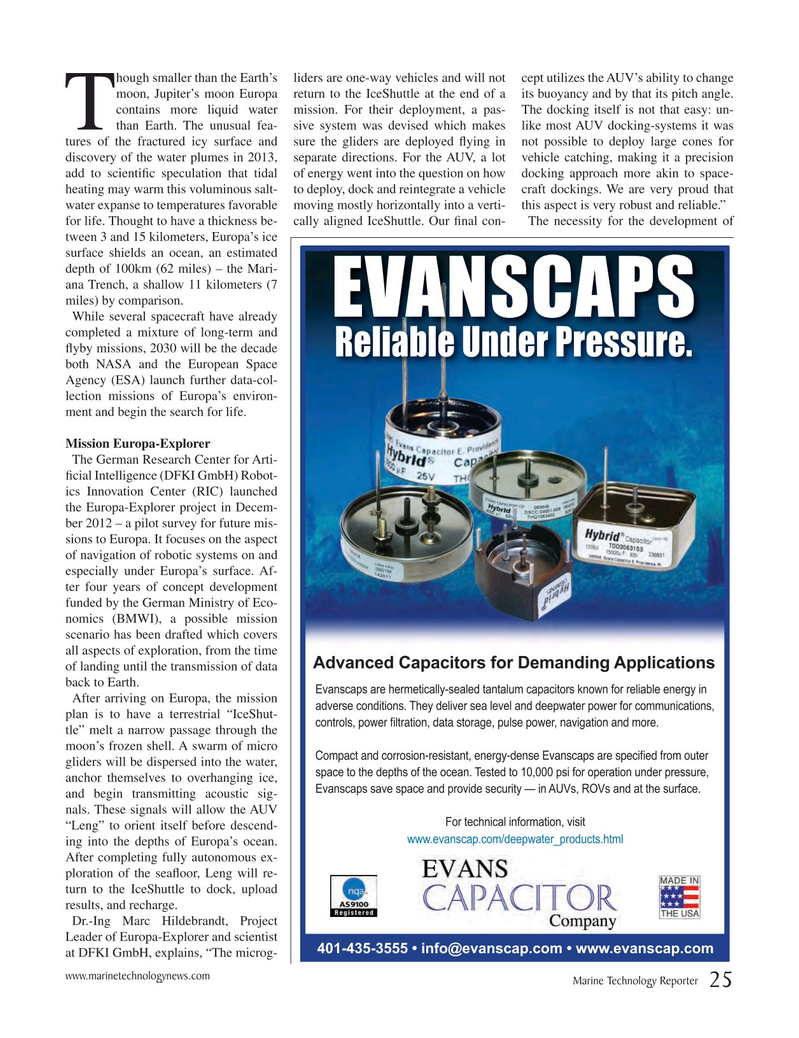
Page 25: of Marine Technology Magazine (October 2016)
AUV Operations
Read this page in Pdf, Flash or Html5 edition of October 2016 Marine Technology Magazine
hough smaller than the Earth’s liders are one-way vehicles and will not cept utilizes the AUV’s ability to change moon, Jupiter’s moon Europa return to the IceShuttle at the end of a its buoyancy and by that its pitch angle. contains more liquid water mission. For their deployment, a pas- The docking itself is not that easy: un-
Tthan Earth. The unusual fea- sive system was devised which makes like most AUV docking-systems it was tures of the fractured icy surface and sure the gliders are deployed ? ying in not possible to deploy large cones for discovery of the water plumes in 2013, separate directions. For the AUV, a lot vehicle catching, making it a precision add to scienti? c speculation that tidal of energy went into the question on how docking approach more akin to space- heating may warm this voluminous salt- to deploy, dock and reintegrate a vehicle craft dockings. We are very proud that water expanse to temperatures favorable moving mostly horizontally into a verti- this aspect is very robust and reliable.” for life. Thought to have a thickness be- cally aligned IceShuttle. Our ? nal con- The necessity for the development of tween 3 and 15 kilometers, Europa’s ice surface shields an ocean, an estimated depth of 100km (62 miles) – the Mari- ana Trench, a shallow 11 kilometers (7 miles) by comparison.
EVANSCAPS
While several spacecraft have already completed a mixture of long-term and ? yby missions, 2030 will be the decade
Reliable Under Pressure.
both NASA and the European Space
Agency (ESA) launch further data-col- lection missions of Europa’s environ- ment and begin the search for life.
Mission Europa-Explorer
The German Research Center for Arti- ? cial Intelligence (DFKI GmbH) Robot- ics Innovation Center (RIC) launched the Europa-Explorer project in Decem- ber 2012 – a pilot survey for future mis- sions to Europa. It focuses on the aspect of navigation of robotic systems on and especially under Europa’s surface. Af- ter four years of concept development funded by the German Ministry of Eco- nomics (BMWI), a possible mission scenario has been drafted which covers all aspects of exploration, from the time $GYDQFHG&DSDFLWRUVIRU'HPDQGLQJ$SSOLFDWLRQV of landing until the transmission of data back to Earth.
Evanscaps are hermetically-sealed tantalum capacitors known for reliable energy in
After arriving on Europa, the mission adverse conditions. They deliver sea level and deepwater power for communications, plan is to have a terrestrial “IceShut-
FRQWUROVSRZHUÀOWUDWLRQGDWDVWRUDJHSXOVHSRZHUQDYLJDWLRQDQGPRUH tle” melt a narrow passage through the moon’s frozen shell. A swarm of micro &RPSDFWDQGFRUURVLRQUHVLVWDQWHQHUJ\GHQVH(YDQVFDSVDUHVSHFLÀHGIURPRXWHU gliders will be dispersed into the water, space to the depths of the ocean. Tested to 10,000 psi for operation under pressure, anchor themselves to overhanging ice,
Evanscaps save space and provide security — in AUVs, ROVs and at the surface. and begin transmitting acoustic sig- nals. These signals will allow the AUV
For technical information, visit “Leng” to orient itself before descend- www.evanscap.com/deepwater_products.html ing into the depths of Europa’s ocean.
After completing fully autonomous ex- ploration of the sea? oor, Leng will re- turn to the IceShuttle to dock, upload results, and recharge.
Dr.-Ing Marc Hildebrandt, Project
Leader of Europa-Explorer and scientist ?LQIR#HYDQVFDSFRP?ZZZHYDQVFDSFRP at DFKI GmbH, explains, “The microg- www.marinetechnologynews.com
Marine Technology Reporter 25
MTR #8 (18-33).indd 25 9/27/2016 1:51:38 PM

 24
24

 26
26
